Stay Updated with Everything about MDS
Thank you! Your submission has been received!
Oops! Something went wrong while submitting the form.
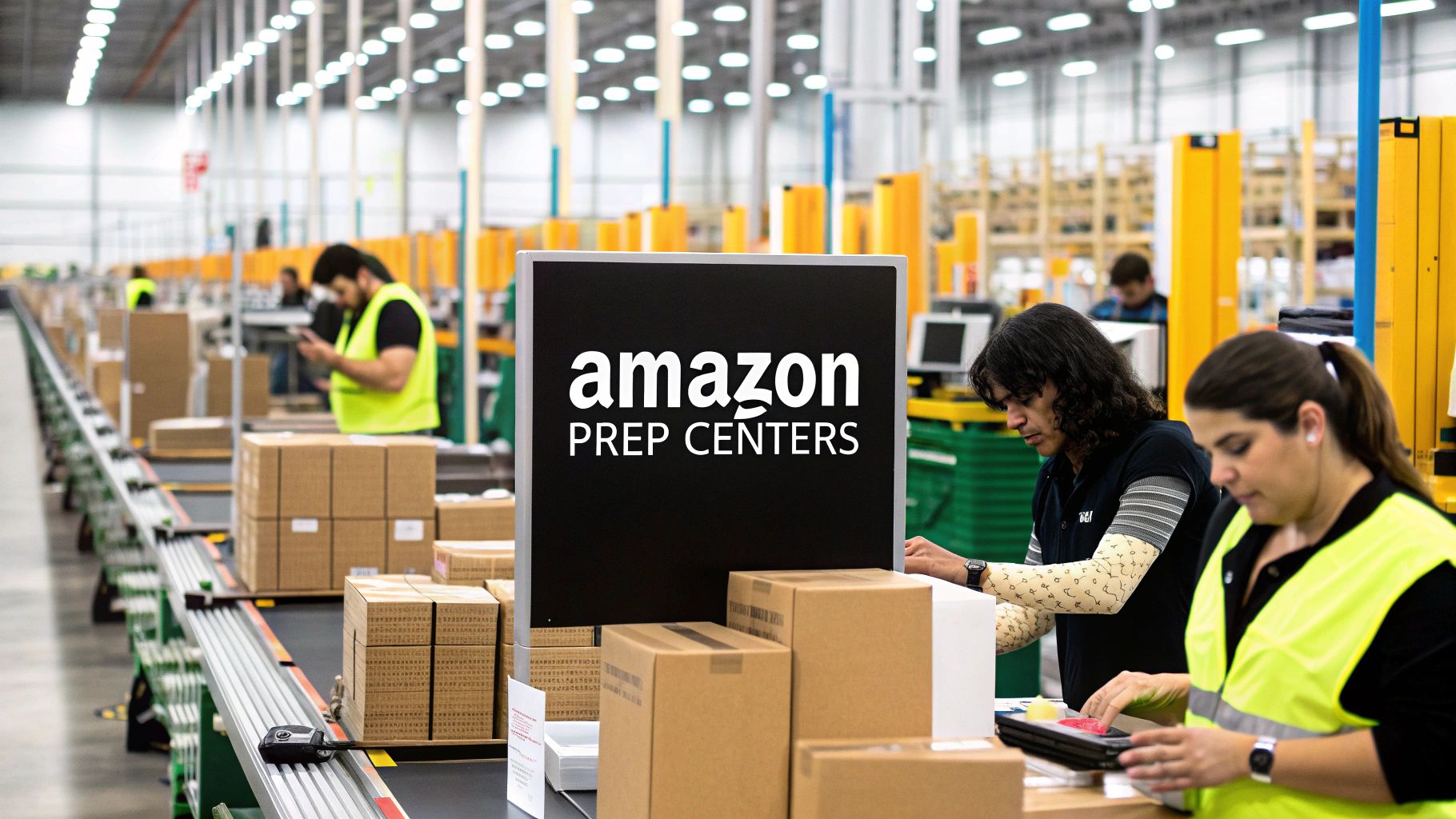
Chilat Doina
August 21, 2025
So, what exactly is an Amazon prep center? Think of it as a specialized logistics partner—a pit crew for your e-commerce brand. They take your inventory and handle all the nitty-gritty prep work required to meet Amazon's notoriously strict Fulfillment by Amazon (FBA) standards.
From inspecting and labeling to bagging and boxing, they get your products ready for Amazon's warehouses. This step is absolutely crucial for making sure your inventory arrives compliant, helping you sidestep costly penalties and frustrating shipping delays.
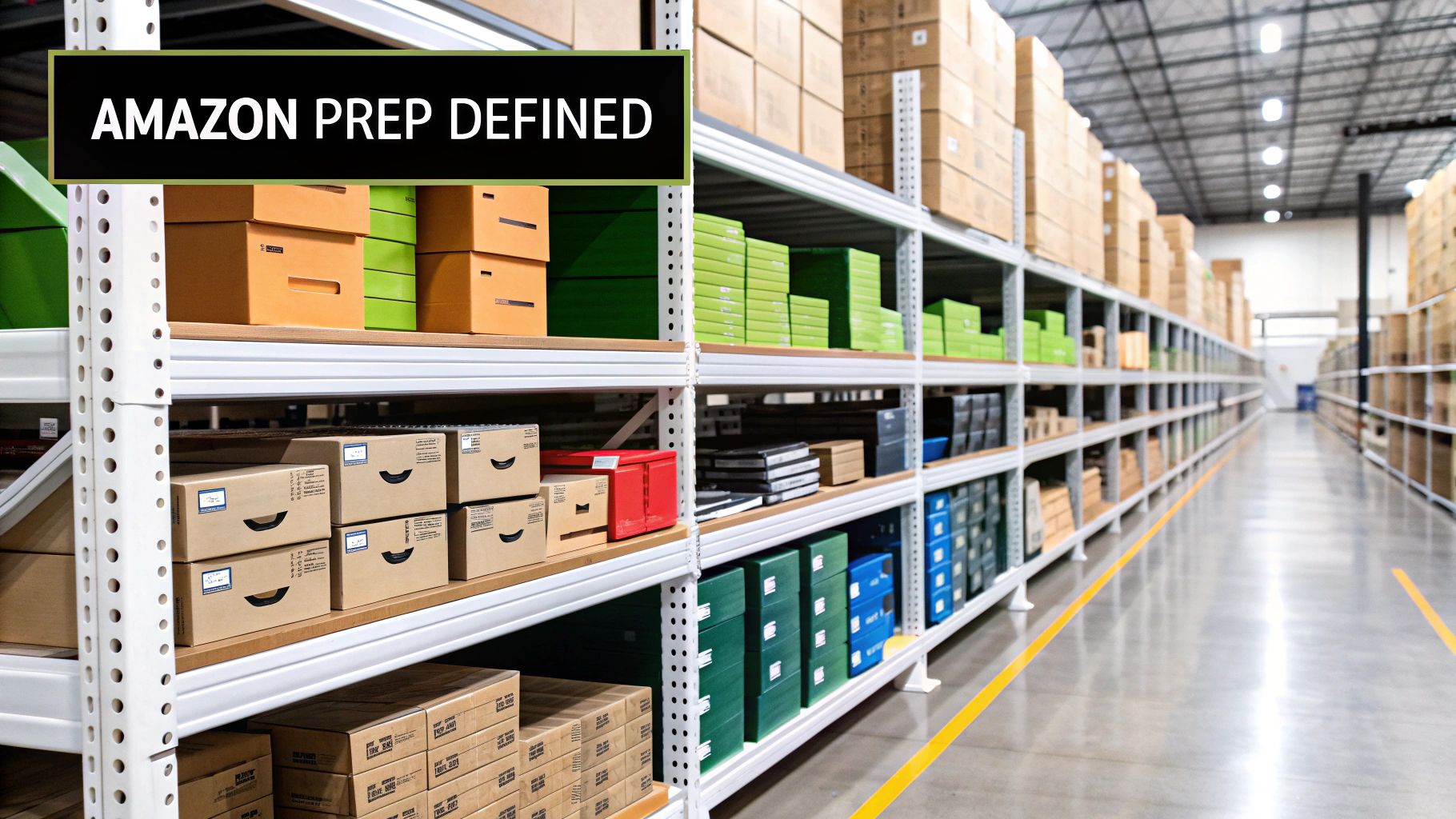
Picture this: you've just landed a fantastic product from an overseas supplier. The inventory is manufactured and ready to go, but there's a huge gap between the factory and Amazon's fulfillment network. Amazon has a massive, constantly evolving rulebook for product preparation, and one tiny mistake—like using the wrong-sized poly bag or putting an FNSKU label in the wrong spot—can get your entire shipment rejected.
This is precisely the problem Amazon prep centers were created to solve. They act as the essential bridge, making sure your inventory flows seamlessly from your supplier to Amazon's shelves, ready to be sold. Forget about cramming boxes into your garage for an all-night labeling session; you just ship everything directly to a professional facility.
These facilities become your hands-on operations team, tackling a whole menu of tasks to get every single unit FBA-ready.
Here’s a quick rundown of their typical services:
Outsourcing these tedious but vital tasks frees up your most valuable asset: time. It lets you focus on what really moves the needle—sourcing new products, marketing your brand, and planning your growth—instead of getting lost in the logistical weeds.
Let's be honest, many sellers get into e-commerce to build a business, not to become a one-person packing and shipping department. The table below breaks down the common pain points that can drain your energy and how a prep center directly solves them.
By offloading these operational hurdles, you professionalize your supply chain and create a much more scalable, resilient business.
The rise of prep centers mirrors the explosive growth of third-party selling on Amazon. They’ve become a fundamental piece of the e-commerce supply chain, especially for sellers who rely on the FBA program.
With roughly 2.5 million active Amazon sellers around the globe and more than 82% of them using FBA, the need for efficient, compliant prep services has never been higher. These facilities are the specialized partners that let sellers scale their operations without being choked by physical or labor constraints.
For any seller serious about achieving operational excellence, a prep center isn't just a luxury—it's a powerful strategic advantage. It protects your brand from the common logistical tripwires that can derail an otherwise successful business. If you're exploring the broader Amazon ecosystem, particularly in regulated categories, you might find this complete guide to selling supplements on Amazon helpful, as proper prep and fulfillment are key pillars of success there, too.
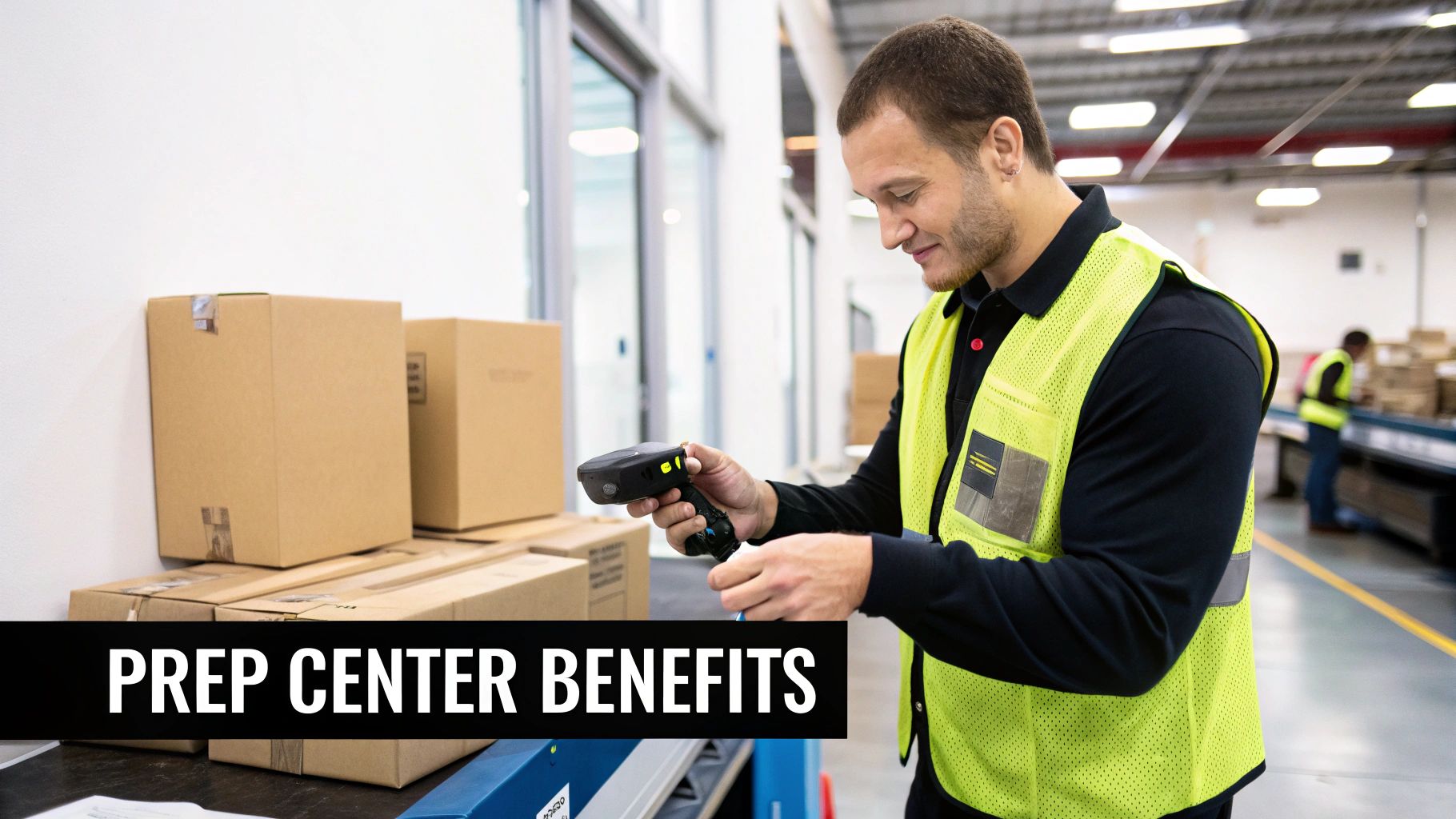
Bringing an Amazon prep center into your corner is so much more than just outsourcing the grunt work of packing and labeling. It’s a serious strategic move that can completely change the game for your business.
Think of it this way: you’re instantly hiring an expert logistics department. This lets you finally stop working in your business and start working on it. The benefits aren't just theoretical—they have a real impact on your time, your bottom line, and your ability to grow.
The biggest win? You get your time back. Every single hour you spend wrestling with packing tape, printing FNSKU labels, or inspecting inventory is an hour you aren't spending on activities that actually make you money. By offloading these tedious tasks, you free yourself up to focus on what really drives growth.
That new freedom means you can finally dedicate real energy to the core of your e-commerce operation. Suddenly, you have the bandwidth for smart product sourcing, crafting killer marketing campaigns, and digging into your performance data. For sellers ready to scale, figuring out how to increase Amazon sales becomes the main event, not something you try to squeeze in between trips to the post office.
Beyond just saving time, using a prep center often means you’ll save a significant amount of money on shipping. These places are shipping wizards, handling massive volumes every single day. That gives them access to deeply discounted commercial shipping rates that you and I could only dream of.
They do this by consolidating your inventory with shipments from their other clients, creating huge, cost-effective LTL (Less Than Truckload) pallet shipments. This strategy absolutely slashes your inbound transportation costs to Amazon's fulfillment centers. Instead of paying a fortune for a bunch of small parcel shipments, you get to ride the coattails of their economies of scale. Those savings go directly back into your pocket, beefing up your profit margins on every single unit sold.
A professional prep center transforms your supply chain from a potential bottleneck into a competitive advantage. It’s the operational backbone that supports rapid, sustainable growth by removing the physical limitations of space, labor, and time.
This immediately boosts your operational efficiency. A prep service vaporizes the physical constraints that can choke a growing business. You no longer have to sweat about where to store 500 units of your next hot product or how you’ll possibly prep a huge shipment during a chaotic week.
Maybe the most powerful benefit of all is the ability to scale without hitting a ceiling. With a prep partner, your business is no longer trapped by the size of your garage or the number of hours in a day. You can confidently place massive inventory orders from suppliers, knowing a professional team is ready to receive, process, and ship thousands of units for you.
This kind of scalability is what separates the hobbyists from the professional brands. It allows you to:
Finally, and this is a big one, a prep center is your best defense against expensive compliance headaches. Amazon's rules for packaging and prep are notoriously strict and can change on a whim. One tiny mistake—an incorrect label, the wrong polybag—can get an entire shipment rejected. That means costly unplanned service fees and, in some cases, even dings on your account health.
Expert prep centers live and breathe these regulations. Their entire process is built around making sure every unit is 100% compliant before it ever leaves their building. This expertise shields you from costly mistakes, protects your seller account, and makes sure your inventory gets checked in and becomes sellable without frustrating delays. They handle the compliance nightmare so you don't have to.
So, what actually happens when you send your inventory to an Amazon prep center? It might sound like a complicated logistical nightmare, but it's really a smooth, well-oiled machine.
Think of it like a relay race. Your supplier runs the first leg and passes the baton (your products) to the prep center. The prep center then does all the necessary work to get it ready before handing it off cleanly to Amazon's fulfillment network for the final stretch.
Once you understand this flow, the whole thing clicks into place. It’s not a confusing puzzle; it’s just a series of straightforward steps designed to get your products ready to sell, fast.
Here's a great visual breakdown of the key stages your inventory goes through.
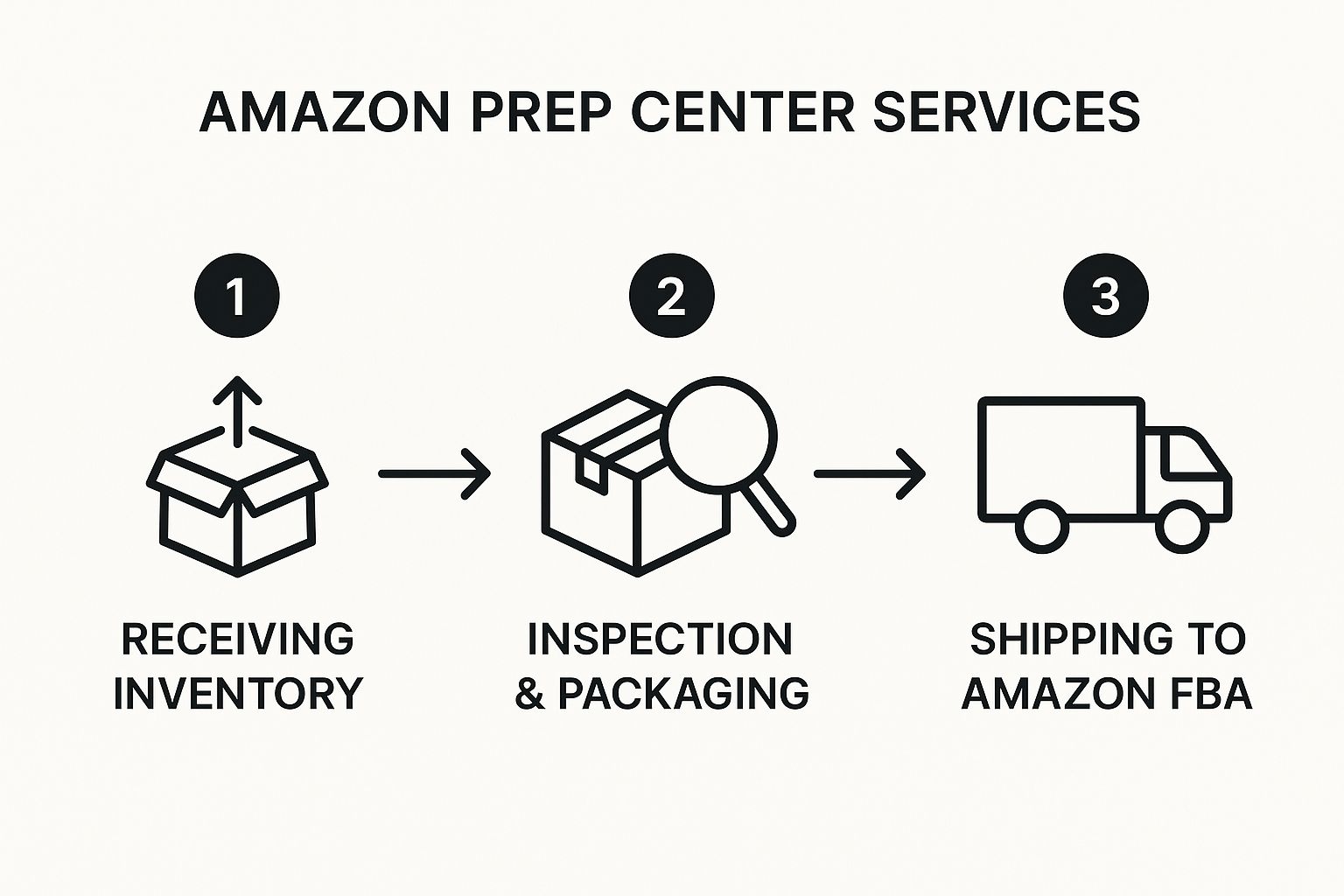
As you can see, it's a funnel. Everything is designed to move your products along efficiently while making sure every single one of Amazon's strict rules is followed to the letter.
It all starts the minute you sign up. Your new prep center will give you a unique account number or a suite address. This little detail is absolutely critical—it's how they'll know that box of inventory belongs to you and not one of the hundreds of other sellers they work with.
Your only job here is to tell your supplier to ship your products to the prep center's address, making sure that unique identifier is plastered all over the shipping labels. This one simple step prevents your inventory from getting swallowed up in the warehouse.
The moment your shipment arrives, the prep center team jumps into action. Think of this stage as your first line of defense against any quality control disasters.
Here’s what they do:
This careful inspection process ensures only top-quality, sellable inventory moves forward, protecting your money and your reputation.
Now for the main event: the "prep." This is where a great prep center really earns its keep by navigating Amazon's maze of rules.
Depending on what you're selling, this stage could involve a whole menu of tasks.
This is where the magic really happens. A skilled prep team can take a messy bulk shipment from a supplier and turn it into a stack of perfectly compliant, FBA-ready units, all prepped to meet Amazon's latest guidelines.
Common prep work includes:
The level of detail required is what separates a true prep center from a generic warehouse. If you want to dig deeper into these differences, check out our guide to 3PL logistics for Amazon, where we break down the pros and cons.
The last step is to get your beautifully prepped products on their way to Amazon. You'll create an FBA shipping plan in your Seller Central account (or you can grant the prep center limited access to do it for you). This plan tells Amazon exactly what's coming and which of their warehouses to send it to.
From there, the prep center packs everything into shipping boxes, applies the Amazon-generated box labels, and schedules a pickup with one of Amazon's carriers. They often build pallets with shipments from multiple sellers, which is a huge money-saver on your inbound shipping costs.
Once the truck pulls away, they'll send you the tracking info, and your work is done. It's a system designed to handle massive scale—and it needs to be. With 9.7 million registered Amazon sellers globally and over 1.1 million new sellers jumping in last year alone, these prep centers are the secret weapon for managing Amazon's increasingly complex network.
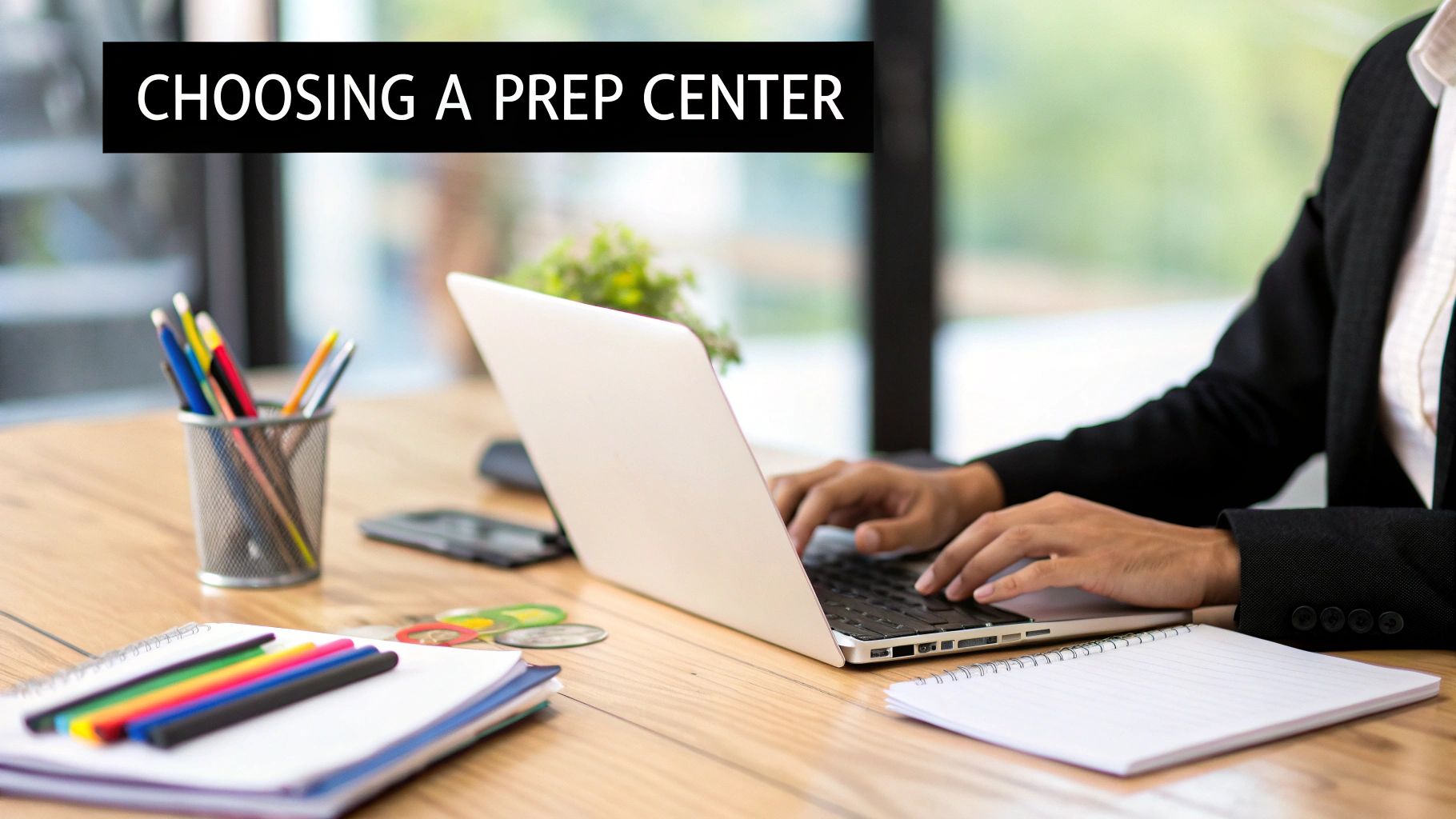
Let's get straight to it: you need to nail down the costs of using an Amazon prep center to protect your profit margins. Think of it as a crucial investment. If you get a handle on the pricing structure now, you can budget properly, figure out your ROI, and dodge any nasty financial surprises later.
Most prep center pricing works like an à la carte menu at a restaurant—you only pay for what your products actually need. This gives you a ton of flexibility, but you have to know what's on the menu to begin with. The good news is that most charges are per-unit, making the math pretty straightforward once you know the basic components.
Almost every prep center invoice you'll see is built around a few core services that every FBA seller needs. These are the non-negotiables.
Your costs will almost always include:
These are the foundational fees. Once you understand them, you can start comparing different Amazon prep centers and see how they stack up.
Not all products are created equal, and your prep costs will absolutely reflect that. A few key variables can swing your per-unit price up or down, so it pays to know what they are.
The biggest driver is complexity. A simple, standard-sized product that just needs an FNSKU sticker will be cheap to process. But as you add more steps, the cost naturally goes up.
The goal isn't just to find the cheapest provider, but the one offering the best value. Solid, error-free prep work stops Amazon from rejecting your shipments or hitting you with fees, making a slightly higher per-unit cost a smart investment in your business's health.
For instance, a fragile glass vase that needs to be carefully swaddled in bubble wrap is going to cost more than a durable plastic toy. Building multi-item bundles or kits is another perfect example—it's more hands-on work, so it's priced higher. Your order size matters, too. Most prep centers give discounts for higher volumes, so the more you send, the less you pay per item.
Beyond the direct prep fees, using a third-party service can be one of many effective strategies to reduce operating costs for your entire business.
To give you a real-world idea of what to expect, let's look at some ballpark figures for common services. Prices will definitely vary based on the prep center's location and scale, but this table should give you a solid baseline for your estimates.
To help you budget, here's a quick look at what you can expect to pay for the most common prep services.
One last tip: always ask about hidden costs. Some centers might have a one-time account setup fee, monthly minimums, or extra charges for oversized and overweight items. A trustworthy partner will be upfront with a crystal-clear price list, so you know exactly what you’re paying for from day one.
Picking the right Amazon prep center is more than just outsourcing a few tasks. It's about finding a strategic partner who becomes an extension of your own team. This single decision ripples through your entire business, affecting everything from your operational agility and profit margins to your ability to actually scale.
You're not just looking for the cheapest quote. You're searching for a reliable partner who will actively help you grow. To do that, you need to look past the price sheet and dig into the details that separate an adequate service from an exceptional one.
Before you even think about costs, you need to get a feel for how a prep center operates. These qualitative factors are often the make-or-break elements of the relationship.
Start with communication. How responsive are they? Send an email and see what happens. Do you get a thoughtful reply within a few hours, or are you left waiting for days? When a shipment has an urgent problem, you'll be glad you picked a partner who communicates clearly and quickly.
Next, get into their actual capabilities:
Think of choosing a prep center like hiring a remote operations manager. You need to trust their judgment and be confident they can handle challenges without you looking over their shoulder. This partnership is the bedrock of a scalable FBA business.
For FBA sellers, making smart operational choices is a huge part of the game. You can dive deeper into building a solid Amazon business in our detailed guide for top-tier FBA sellers on Amazon.
Where your Amazon prep center is located can give you a serious competitive edge. A facility in a sales-tax-free state like Oregon or Delaware, for example, can save you a small fortune on inventory purchases over the course of a year.
Also, think about logistics. A center near a major port like Los Angeles or New York can slash inbound shipping times and costs if you're importing goods. This kind of strategic placement is a game-changer for your supply chain. Prep centers act as the quality gatekeepers for Amazon's massive fulfillment network. With clusters of fulfillment centers in states like California (35 centers) and Texas (28 centers), Amazon is all about speed—roughly 92% of Prime members are within a one-day ground delivery zone. To get a better sense of this massive operation, you can read the full research about North America's largest warehouses.
As you’re vetting potential partners, keep your eyes peeled for warning signs that could spell trouble later on. A few red flags should give you serious pause.
Be wary of any center with a confusing or convoluted pricing structure. If you can't easily figure out what you'll be paying, you're setting yourself up for surprise fees. Another huge red flag is a trail of bad online reviews or a total lack of testimonials from happy clients.
And finally, if a prep center is slow to get back to you while they're trying to earn your business, run. Their communication isn't going to magically get better once you're a paying customer. Trust your gut and partner with someone who is professional and transparent from the very first email.
It's one thing to understand the high-level benefits, but it's another to figure out how an Amazon prep center actually fits into your day-to-day. You've probably got some specific questions floating around, and that's a good thing. Digging into the details is how you make a smart call for your business.
We've been there. To help you get the clarity you need, we’ve rounded up some of the most common questions sellers have when they’re on the fence about using a prep service.
Not only do you need one, it might be the single best move you can make early on. A prep center instantly solves the problem of a garage overflowing with inventory and boxes, letting you run your business from a laptop anywhere in the world.
But the real win is buying back your time. Instead of spending hours taping boxes, you can focus on the stuff that actually grows your business, like sourcing killer products and marketing. By starting with a professional service, you sidestep rookie mistakes with Amazon's strict prep rules—mistakes that can get your shipments rejected and cost you dearly.
For a small seller, a prep center isn't about saving space. It's about buying back your most valuable asset—time—and pouring it into strategies that turn a small operation into a big one.
This move lets you operate with the efficiency of a much larger brand, without sinking a fortune into a warehouse and staff.
Absolutely. Most full-service Amazon prep centers handle returns management, sometimes called "reverse logistics." This is a huge operational win, especially if you don't want a mountain of returned products showing up on your doorstep.
Instead of Amazon sending returns back to you, they go directly to your prep center. From there, the team inspects every item to figure out its condition.
Here's the typical play-by-play:
This service is a lifesaver for protecting your inventory quality and turning the nightmare of customer returns into a smooth, managed process.
This is a big one, and you're right to be cautious about security. Rule number one: Never, ever share your main login and password. Not with anyone.
The right way to do this is by granting limited "User Permissions" inside your Seller Central account. This gives your prep center access to only the tools they need to manage shipments, while keeping them completely walled off from your financial data and other sensitive business info.
It’s a straightforward process:
This lets them create shipping plans and print labels for you, but they can't see your sales reports, payment details, or anything else. Any legit prep center knows this drill and should walk you through it.
Good question. People often use these terms interchangeably, and while there's overlap, the core difference is specialization vs. generalization.
An Amazon prep center is a specialist. They live and breathe one thing: getting products ready according to Amazon's very specific, sometimes bizarre, FBA requirements. They're the experts on FNSKU labels, poly bags, bundling, and navigating the ever-changing rulebook.
A Third-Party Logistics (3PL) provider is a generalist. They handle the whole suite of logistics—warehousing, order fulfillment, shipping—for multiple sales channels. That could be your own Shopify store, other marketplaces like Walmart, and wholesale orders.
Many 3PLs do offer Amazon prep, but it's just one service on a much bigger menu. If you're 100% focused on Amazon, a dedicated prep center is often the smarter, more dialed-in choice. But if you're building an omnichannel brand and selling everywhere, a 3PL that has solid FBA prep capabilities might be the better all-in-one partner.
Ready to connect with a community of top-tier e-commerce founders who have mastered these kinds of operational challenges? Join Million Dollar Sellers to gain access to an exclusive network of 7, 8, and 9-figure sellers who share actionable strategies for scaling smarter. Apply for your invitation at https://milliondollarsellers.com.
Join the Ecom Entrepreneur Community for Vetted 7-9 Figure Ecommerce Founders
Learn MoreYou may also like:
Learn more about our special events!
Check Events